Walleyes migrate in fall for a variety of reasons. They move to better habitat for wintering. They move to intercept massive baitfish migrations. Sometimes they settle in near spawning locations, though spawning is months away.
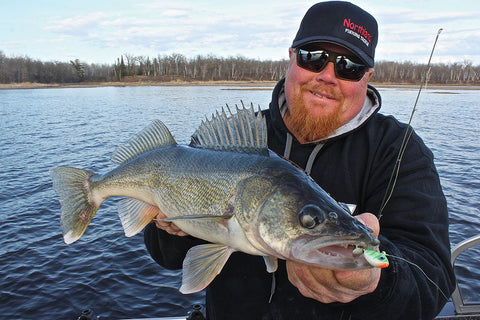
Famous Minnesota guide, Brian “Bro” Brosdahl, with a Rainy River fish, caught pitching from a “spot locked” position with a Northland Whistler Jig tipped with a minnow.
The water is cooler than it was. The days shorter. The wind stronger. Walleyes begin to move. Cycles turning in an ancient, time-worn groove. Weaving through the shadow of ship wrecks and concrete abutments, along weedlines and past rip-rap they come. Through the nebulous haze ahead comes the hint of current. Familiar scents from cycles past.
It happens every fall. Walleyes pick up shop and leave stillwater haunts for rivers all across the Great Lakes region. Notable examples include the return of Lake Ontario walleyes to the rivers entering the Bay of Quinte, Lake Huron walleyes returning to the Saginaw River, Erie ‘eyes running the Detroit River, and the Capistrano-like flocking of walleyes from Lake Winnipeg back into the Red Rivers—bucket-list spots for a shot at a 15 pounder. Not all walleyes migrate to rivers, but even lake-bound walleyes make locational changes in fall, and the walleyes already living in rivers move, too.

Vertical jigging or pitching and drifting a jig-minnow combo from an anchored position is a proven method for catching migrating walleyes in big rivers like the Rainy on the Minnesota-Ontario border.
Timing the great runs requires good inside information. Asking the right questions makes all the difference—Like: What triggers the migration in your area? “Good question,” replies Gord Pyzer, former fisheries manager with the Ontario Ministry of Natural Resources. “I think it’s a combination of things. Depending on where the lake is, the emphasis could be on different things in each area.”
Walleyes migrate in fall for a variety of reasons. They move to better habitat for wintering. They move to intercept massive baitfish migrations. Sometimes they settle in near spawning locations, though spawning is months away. Most migrations are thought to be triggered by:
- Genetics—following spawning strategies millions of years old;
- Day length (days getting noticeably shorter);
- Water temperature;
- Water level; or 5. Forage movements. As Pyzer points out, the real reason is probably some combination of all the above with a few jokers in the deck we don’t even know about yet.
Whatever triggers them, fall walleye migrations to rivers often have something to do with the spawning cycle. You might call it a pre pre-spawn migration. Many walleyes spawn in lakes, and won’t run up rivers and streams in fall, except to make short, back-and-forth foraging forays. “The ones that run rivers in fall tend to hole up near their eventual spawning sites,” Pyzer said. “The Thames River in Ontario is a classic example. Walleyes cross vast distances to get there and they pull up adjacent to eventual spawning grounds. They arrive from late September through October and won’t spawn until March.”
Some rivers have no fall run, yet host spawning walleyes in spring. Those wall-eyes still migrate in fall, usually staging outside the mouth of the river where they were born until early spring, when they run upstream to spawn.

Lake Of The Woods on the Ontario—Minnesota border has river spawners that run the Rainy River in fall, but the runs can be inconsistent. The majority of the females, and sometimes the majority of walleyes in general, don’t seem to run until April some years. Many other rivers have variable fall runs of walleyes as well. This could be an indication that water levels and forage populations, which vary from year -to-year, may have something to do with how many walleyes run upstream to winter. Without a massive run of bait, most rivers can’t support the added volume of predators associated with a walleye run from bigger systems. Lake of The Woods also has many lake-spawning walleyes, and they migrate in fall, too. But not up rivers. “On Lake of the Woods and Rainy, it seems ciscoes key the fall migrations,” Pyzer noted. “Walleyes tend to stack up in the areas where ciscoes spawn.” Despite all the differing aspects, fall walleye migrations everywhere seem to share one common key to timing: massive baitfish migrations.
THE FORAGE FACTOR
Gizzard shad spawn in spring, but begin moving in fall. Missouri River shad migrate fairly long distances within the river itself, and walleyes follow in fall in South Dakota. Shad in the Great Lakes and many natural lakes move into river mouths and harbors from September through November. Shad begin moving into Michigan’s Saginaw River, for example, in September, and the run peaks in October. “The river boils from bank to bank with gizzard shad,” biologist Jim Baker with the Michigan Department of Natural Resources (DNR) once told me. Walleyes will be close behind.
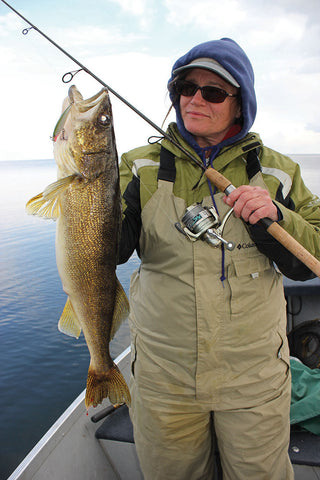
Fall walleye migrations to rivers often have something to do with the spawning cycle. You might call it a pre pre-spawn migration.
Ciscoes (lake herring) spawn in late fall or early winter and tend to be lake spawners, though some populations spawn in current. This is evidenced by the ciscoes of Lake Bemidji, which mass into the Mississippi River each fall in Minnesota. Alex Keszler, walleye tournament pro from Winnipeg, says the key to the massive schools of walleyes migrating to the Win-nipeg River every fall is the ciscoe run. “The massive tullibee (ciscoe) run comes into the Winnipeg around the end of November, or the beginning of December. You’ll see the birds going nuts and chrome tulibees jump-ing all over the surface. When that happens, the fishing gets really tough. Too much bait. Plus, the later it gets in fall, the tougher it is to catch big walleyes on the Winnipeg River near Lake Winnipeg. A lot of people think the females leave the river in late fall and come back just before spawning in the spring.
“But the Red River, which enters Lake Winnipeg 40 miles to the south, has big females in the river all winter long. An 8-pounder is considered common during the ice fishing season on the Red. Toward the end of March, they start opening the locks and it messes up the river, and the big walleyes won’t bite, but they’re there. In the Red, walleyes come in a little earlier than in the Winnipeg—a couple weeks earlier. So, maybe the shiners show up earlier. The Red gets a massive emerald shiner run.”
Emerald shiners are famous for staying in the river, wandering farther upstream and wintering over, while ciscoes end up back in the big lakes by late autumn, early winter.
John Hook, longtime informant to In-Fisherman on the movements of Great Lakes walleyes, guided on the AuSable River in Michigan for over 20 years. Just north of Saginaw Bay, the AuSable draws some real horses in the fall. “The walleyes show up when the gizzard shad or emerald shiners move in,” Hook explains. “It starts out in the lake in September, when baitfish move toward shore as the water cools, because it’s warmer up on the beaches. The shad run is the key to dynamite fishing. When we don’t get a good shad run, it will be a mediocre year on the river, so a lot depends on the shad population, which fluctuates quite a bit. We always have some walleyes running the river in fall, regard-less of the shad run, but the best fishing always occurs when the shad come in thick.”
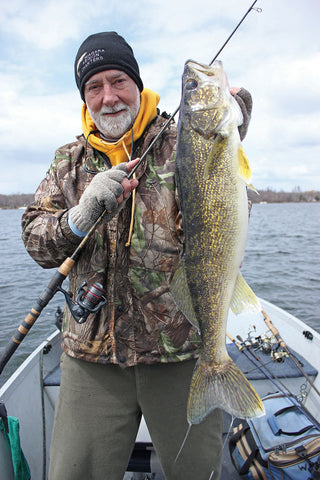
Trolling minnow baits is one of the most effective and efficient ways to catch fall wall-eyes. Suspending baits are often overlooked and should be “snap trolled” with the rod in hand, dropping it back to create lots of pauses then snapping or twitching it forward.
According to Kevin Kayle, fisheries biologist-supervisor for the Ohio DNR, Lake Erie’s gizzard shad hang around by river mouths all winter, but never wander very far upstream. “Shad are spring spawners, but they come into the rivers in fall for stability when the lake is turning over. Turnover usually occurs within the first couple weeks of September. Shad hang around in stream mouths and harbors until spring, but they usually don’t go far, never past the first riffle, dam or rapids.”
But it’s certainly difficult to envision hordes of hungry walleyes rolling upstream and staking out claims for several months in rivers that don’t have the means to sup-port them. Baitfish species that run rivers in fall seem to be the most telling indicators of when the walleye run begins, how far walleyes will run those rivers, and how long they stay. To determine when and how far walleyes migrate in any given system, learn which species of baitfish—if any—run the rivers in fall. THE
WATER LEVEL CONNECTION
The Detroit River receives approximately 16 million walleyes from Erie during the fall and spring spawning runs. Mark Turner, fisheries biologist with the Ohio DNR, worked on one of the most extensive walleye-tagging programs in history on Lake Erie. “The Maumee River probably gets the next biggest run of walleyes from Erie,” Turner said. “And the Sandusky River would be next. But walleyes don’t re-ally migrate up those last two rivers in fall. They stage outside the river mouth, and enter rivers to feed several times a day and drop back out. In the Huron River, where walleyes don’t even spawn, they do the same thing. Those fish are probably lake spawners, congregating to take advantage of staging baitfish that run rivers in fall. Lake spawners far outnumber river spawners in Lake Erie.”
Not enough forage upstream? Is water quality a factor? Not enough depth? If walleyes can’t find extensive areas deeper than 15 feet, they can’t comfortably exist in rivers through winter at some latitudes. The farther north a river is, the deeper it likely needs to be to harbor many holdover walleyes. And, of course, depth is affected by water level. Annual differences in rainfall could account in part for the “good year, bad year” fall-migration syndrome in some rivers.
Wind can affect water levels, too. The Winnipeg and Red rivers, where Keszler fishes, enter the south side of sprawling Lake Winnipeg. “When the wind blows from the south, both spots slow down,” Keszler said. “Seiche effect can raise or lower water levels, which affects migrations. But cold front days are the best days. Some of the best walleye fishing occurs in some of the nastiest weather imaginable, and, of course, the wind typically comes out of the north during cold fronts.”
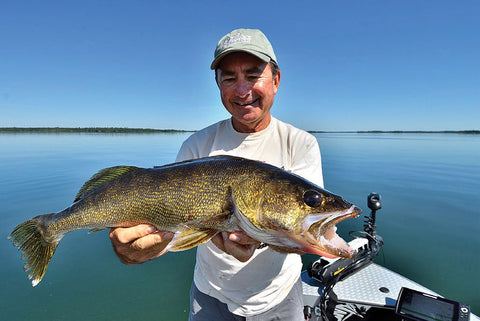
Gord Pyzer, former Ontario Ministry of Natural Resources fisheries manager, opines that walleyes run up many Great Lakes region rivers in fall for a variety of reasons, even though they won,’t spawn until ice-out in spring.
Cold snaps really get the fish chewing all over the region in fall. Warm, stable weather turns walleyes off—just the opposite of summer. It’s a common reaction for walleyes to turn on in fall when the water temperature suddenly drops during a cold snap, signaling the approach of winter.
Regardless of the system in question, when water levels are lower than aver-age, runs tend to be smaller than average. The reverse is true in high-water years. Joe Leonardi, fisheries biologist from the Michigan DNR, said the Flint River (a tributary of the Saginaw) receives a noticeably smaller fall run of bigger females in low-water. “They don’t want to exert the energy required to get over shallow riffles in fall, he said. “They remain in the Saginaw River to stage and overwinter somewhere near the mouth of the Flint. Males were always present upstream in November, it seemed, regardless of water level. But when water levels were normal, more females were found upstream in fall.”
Across the state on the Muskegon River, a tributary of Lake Michigan, water levels are more stable, the river is deeper overall than the Flint, and riffles tend to have a little more water running over them during low-water years. Still, biologists note that the significant fall run can vary according to water levels. The Saginaw, which has a deeper overall profile than the Flint, seems to attract a more consistent fall run. When it comes to the fall run, the percentage of walleyes destined for spawn-ing in the river that actually run in fall could vary by as much as 60 percent from year to year, depending on conditions.
BIG BITE
Walleye fishing in some rivers can get overlooked in fall, even though walleye location during a fall migration is easily determined at times. In rivers, walleyes tend to pause or hold below “barriers.” A barrier is anything that blocks or slows progress. As the water cools into the 30°F range, walleyes begin to settle in for the winter in deeper pools below barriers.
Less obvious things than dams serve as barriers. Rapids and riffles become daunt-ing to a fish that just swam up to 300 miles across the Great Lakes. A long stretch of very shallow water can intimidate a migrating walleye. Not feeling secure about a long swim through shallow water, walleyes often pile up below these stretches until late evening, or well into the dark hours.

Below these barriers, everything screams “big crankbaits.” Baitfish are at morphological peak and abundant. Wall-eyes are moving because baitfish mass near river mouths and actually run way upriver. What are walleyes everywhere trying to accomplish in fall? Build fat reserves. Dragging leeches around is like taking a knife to a gun fight. Sometimes, when warm spells linger, crawlers on spinner rigs can be right. But cranks rule about 8 days in 10—especially after cold fronts.
I use 10-pound Berkley FireLine with a 4-foot, 10-pound Seaguar Fluorocarbon leader tied in with back-to-back uni knots. Braid is more sensitive and, because it’s thinner, it creates less resistance, allowing baits to dig deeper. Drifting and casting certainly works, especially from shore, but trolling covers more water and keeps baits deep. With braid, the lure stays closer to the boat. Walleyes are rabid about feeding in fall, and can be taken on amazingly short lines. Less tangles with other boats that way, too. Just let out enough line to occasionally tap bottom, lock it up and put it in the holder.
Many small river mouths around the Great Lakes get no attention at all in fall. “We troll crankbaits on big flats outside the river mouths, 8 to 12 feet down, looking for little hard spots,” Keszler said. With FireLine you can feel the areas walleyes like. The best spots have a pebbly bottom—tap, tap, boom you get a fish. You have to key in on these spots and throw markers on the little hard-bottom stretches, or mark them with GPS.”
John Hook, about 1,000 miles east and south of Keszler, has a similar take on the fall run. “Crankbaits are key, because these fish are feeding on minnows,” Hook said. “Big baits rule. My favorite lure during the fall run is the F-18 Rapala. I like 10-pound Stren High Impact for trolling. It has less stretch and it’s very sensitive. I like a little stretch. I use an 8-foot medium-action rods with line-counter reels so I know where the lure is. The key distance with a minnow-bait, most days, is from 35 feet to 110 feet back, depending on where walleyes are holding in the water column.
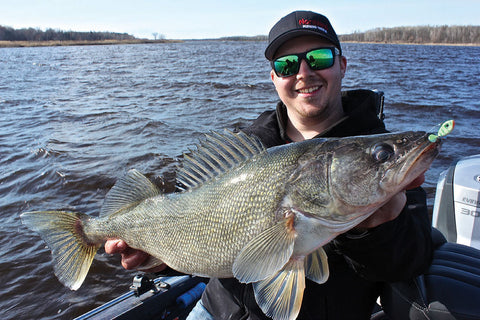
Timing the great runs requires good inside information.
“Peak fishing occurs when shad move into the river, when water temperatures drop below 50°F in the lake. Casting and trolling minnowbaits works best for me,” Hook added. “I’ve tried all different kinds of crankbaits, but minnowbaits rule. Fish do suspend in a river, especially at night. Feeding walleyes can move so high in the water column in a river you can’t even mark them. Basically, I don’t use weight on the line to get the bait deeper in fall, but I use a split shot as a weed deflector. Fish seem to be more scattered. Big walleyes, especially, seem to be more solitary. Bigger fish aren’t as aggressive or as competitive as the smaller fish about chasing minnows. If big walleyes get into a big school, I think their feeding opportunities are reduced.”
As the water cools into the low 40°F range, drifting and working vertically with a jig-minnow combo often produces better numbers, but crankbaits continue to take bigger fish on average, even in water temperatures under 35°F.
Fall walleye runs are awesome. Baitfish boil on the surface, drawing huge concentrations of walleyes as water temperatures plummet with the onset of winter. Big, aggressive walleyes in big numbers with an attitude, slashing at anything that fits in their mouths. What could be better?
Did you enjoy this article? If so, please subscribe today to Great Lakes Angler magazine and support GLA and this website!









